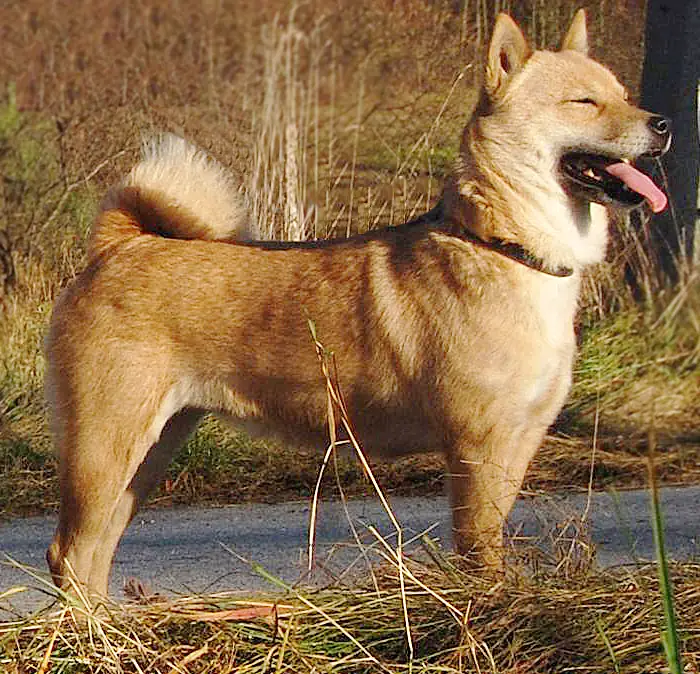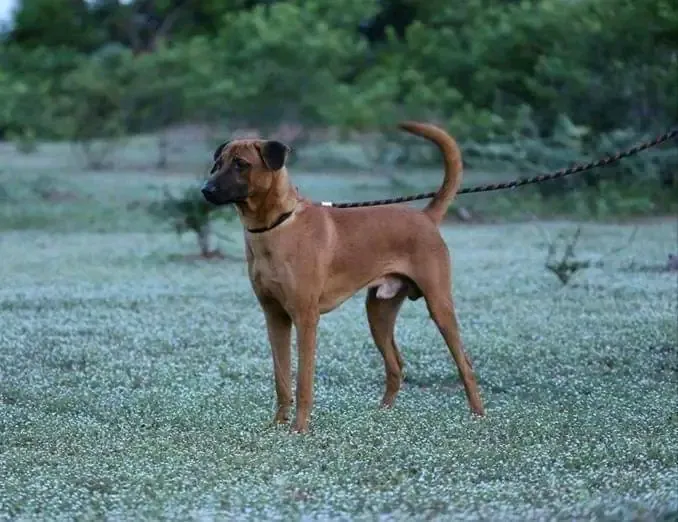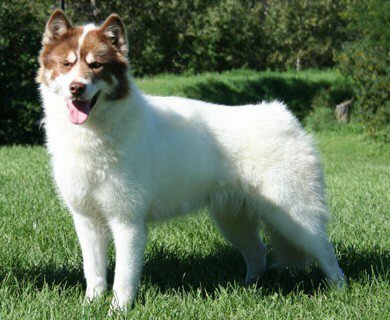Chukotka Sled Dog
The Chukotka Sled Dog, or Sakhalin Husky, is a robust and loyal breed known for its endurance and historical significance as a sled dog. With a rich heritage, they thrive on exercise and companionship.
Overview
🐕Breed Overview
✨Key Traits
💡What Makes Chukotka Sled Dog Special
The Chukotka Sled Dog is characterized by its remarkable endurance and strength, making it an excellent working dog. They have a strong prey drive, which can lead to chasing small animals if not properly trained.
Their affectionate nature makes them great family companions, and they thrive on companionship and social interaction. These dogs are also known for their intelligence and problem-solving abilities, which can be harnessed in training and activities.
Their history as sled dogs contributes to their strong work ethic and desire to be active.
The Chukotka Sled Dog, also known as the Sakhalin Husky, is a remarkable breed with a rich history and a strong connection to its working roots. Originating from Sakhalin Island, this spitz-type dog was bred for its endurance and ability to thrive in harsh climates. With a height ranging from 22 to 26 inches and a weight of 66 to 88 pounds, these dogs are robust and muscular, equipped with a thick double coat that protects them from extreme weather conditions.
Their ears are small and pointed, and they come in various colors, including russet-red and black. Historically, the Chukotka Sled Dog played a vital role in transportation and hunting, making them indispensable companions for their human counterparts. Their claim to fame came during the 1958 Antarctic expedition, where two dogs, Taro and Jiro, survived against all odds, becoming symbols of loyalty and resilience.
This breed's story has been immortalized in films and monuments, showcasing their significance in Japanese culture. In terms of temperament, Chukotka Sled Dogs are known for their affectionate nature, intelligence, and strong work ethic. They thrive on physical activity and require at least 60 to 90 minutes of exercise daily.
Their training should focus on positive reinforcement, as they can be independent and strong-willed. With proper socialization and training, they can be excellent family companions, getting along well with children and other pets. While the breed is rare today, efforts are being made to preserve its lineage and promote its unique qualities.
The Chukotka Sled Dog is not just a pet; it is a living testament to the bond between humans and dogs, embodying the spirit of adventure and loyalty that has defined its history for generations.
🎉Fun Facts
Taro and Jiro, two Chukotka Sled Dogs, became famous for their survival story during the 1958 Antarctic expedition.
The breed is celebrated in Japan with monuments and films that honor its historical significance.
The breed is known for its incredible endurance and ability to work in harsh climates.
Breed Characteristics
Family & Friends
Good Behavior
Get Up & Go
Household Harmony
Temperament & Personality
✨Key Traits
🐕Core Temperament
The temperament of the Chukotka Sled Dog is characterized by loyalty, intelligence, and a strong work ethic. They are affectionate with their families and can be protective when necessary.
These dogs are generally friendly with children and other pets, but early socialization is key to ensuring they are well-adjusted. They can be independent thinkers, which may lead to challenges in training, but with consistent and positive reinforcement methods, they can learn effectively.
Their playful nature makes them enjoyable companions, and they thrive in active households.
💫Personality Profile
Chukotka Sled Dogs are known for their loyal and affectionate nature. They form strong bonds with their families and are generally good with children and other pets.
Their high energy levels mean they require regular exercise and mental stimulation to keep them happy. These dogs are intelligent and eager to please, making them trainable, although they can also be independent and strong-willed.
Socialization from a young age is important to ensure they are well-adjusted and comfortable in various environments. They tend to be reserved with strangers but are protective of their families.
🔊Vocal Tendencies
Chukotka Sled Dogs are generally not excessive barkers, but they will vocalize when excited or alerting their owners to something. They may bark to communicate with their owners or express their needs, but they are not known for being overly noisy.
Their vocalizations can include howling, especially if they are feeling lonely or bored. Overall, they have a moderate noise level, making them suitable for families and living situations where excessive barking may be a concern.
Affection & Social Traits
Energy & Activity
Communication Style
Care Requirements
🏃♂️Exercise Requirements
Daily Exercise
The Chukotka Sled Dog, also known as the Sakhalin Husky, is a highly active breed that requires significant daily exercise to maintain its physical and mental health. Ideally, these dogs need at least 60 to 90 minutes of vigorous exercise each day. This can include activities such as running, pulling sleds, or engaging in dog sports like agility or skijoring.
Given their history as sled dogs, they thrive in environments where they can run and work. Puppies require shorter, more frequent exercise sessions to avoid overexertion, while senior dogs may need gentler activities like walking or swimming to accommodate their changing energy levels. Regular exercise is crucial for preventing behavioral issues such as boredom and destructive tendencies, which can arise from insufficient physical activity.
Overall, a well-exercised Chukotka Sled Dog is a happy and well-adjusted companion.
Preferred Activities
🏠Living & Adaptability
Space Requirements
Chukotka Sled Dogs thrive in spacious environments where they can roam and explore. Ideally, they should have access to a large, securely fenced yard for outdoor play.
While they can adapt to apartment living if given ample exercise, they are best suited for homes with plenty of outdoor space. Owners in smaller living situations should ensure they can provide sufficient daily exercise and mental stimulation through regular outings and activities.
Without adequate space and stimulation, these dogs may exhibit destructive behaviors due to pent-up energy.
Climate Preference
🍲Feeding Guide
Schedule
Food Types
Portion Size
Special Nutritional Needs
Chukotka Sled Dogs require a high-protein diet to support their active lifestyle. It's essential to choose dog food that is rich in animal protein and healthy fats.
Some dogs may have sensitivities to certain ingredients, so monitoring their diet and adjusting as necessary is crucial. Supplements such as omega fatty acids can also be beneficial for maintaining coat health.
✨Grooming Requirements
Grooming Overview
The Chukotka Sled Dog has a thick double coat that requires regular grooming to keep it healthy and free of mats. During shedding seasons, which occur twice a year, daily brushing is recommended to manage the heavy shedding.
Outside of shedding periods, brushing once a week is sufficient. Bathing should be done as needed, typically every few months, to maintain coat cleanliness without stripping natural oils.
Regular nail trimming and ear cleaning are also essential to ensure overall health and hygiene.
Care Schedule
Brush weekly; daily during shedding season; bathe every 1-3 months; trim nails every 2-4 weeks.
Health Profile
⚕️Health Care
Regular health care is vital for the longevity of the Chukotka Sled Dog. Routine veterinary check-ups, vaccinations, and preventive treatments can help catch potential health issues early.
Maintaining a balanced diet, regular exercise, and proper grooming are also essential components of their health care routine. Early detection and management of health issues can significantly impact their quality of life and lifespan.
Health Issues Overview
⏳Average Lifespan
Genetic Factors
Genetics play a crucial role in the lifespan of the Chukotka Sled Dog. Like many breeds, they may be predisposed to certain hereditary health issues, such as hip dysplasia and eye disorders.
Responsible breeding practices that prioritize genetic diversity can help mitigate these risks. Potential owners should seek breeders who conduct health screenings and prioritize the overall health of their breeding stock to ensure a healthy lineage.
Living Conditions
The lifespan of the Chukotka Sled Dog can be influenced by various environmental factors, including housing conditions, climate, and social interactions. Dogs kept in active households with ample outdoor space and regular exercise tend to live longer, healthier lives.
Exposure to extreme temperatures should be managed carefully, as these dogs are adapted to cold climates but can suffer in excessive heat. Providing a stimulating environment with social interactions can also enhance their overall well-being and longevity.
🏥Common Health Issues
Hip Dysplasia
Warning Signs
🔬Diagnosis
X-rays and physical examinations by a veterinarian.
💊Treatment
Medications, weight management, and in severe cases, surgery.
📝Management Tips
Maintain a healthy weight, provide joint supplements, and engage in low-impact exercise.
Eye Disorders (e.g., cataracts)
Warning Signs
🔬Diagnosis
Veterinary eye examinations.
💊Treatment
Surgery may be required for severe cases.
📝Management Tips
Regular vet check-ups and monitoring for vision changes.
Obesity
Warning Signs
🔬Diagnosis
Weight assessments and body condition scoring by a veterinarian.
💊Treatment
Dietary changes and increased physical activity.
📝Management Tips
Controlled diet and regular exercise.
🛡️Preventive Care
🔬Hip Evaluation
Hip Evaluation assesses the dog's hip joints for dysplasia and other abnormalities, which can lead to arthritis and mobility issues.
📅 Annually after 2 years of age.
🔬Ophthalmologist Examination
Eye Examination checks for hereditary eye conditions that may affect vision, ensuring any issues are identified early.
📅 Every 1-2 years, or as recommended by a veterinarian.
🔬Thyroid Function Test
Thyroid Function Test evaluates the dog's thyroid hormone levels to detect hypothyroidism, which can affect energy levels and weight.
📅 Annually after 5 years of age.
Training
🧠Intelligence & Trainability
💪Work Drive
Chukotka Sled Dogs possess a strong work drive, stemming from their history as sled dogs. They thrive when given tasks to complete, whether it's pulling sleds, participating in dog sports, or engaging in interactive play.
Mental stimulation is just as important as physical exercise for this breed. Activities that challenge their problem-solving skills, such as puzzle toys or scent work, can help satisfy their need for engagement.
Without sufficient work or mental challenges, these dogs may become bored and exhibit undesirable behaviors.
⚠️Training Considerations
Chukotka Sled Dogs can exhibit strong-willed and independent behaviors, which may pose challenges during training. Their high energy levels require consistent and engaging training methods to keep them focused.
Common challenges include stubbornness and a tendency to chase small animals due to their strong prey drive. To overcome these challenges, owners should employ positive reinforcement techniques, such as treats and praise, to encourage desired behaviors.
Early socialization and exposure to various environments can also help mitigate behavioral issues, ensuring they develop into well-rounded companions.
📝Training Tips
Training a Chukotka Sled Dog requires patience, consistency, and an understanding of their unique temperament. Positive reinforcement methods work best, as these dogs respond well to rewards for good behavior.
Short, engaging training sessions are recommended to maintain their interest. Incorporating play into training can also enhance their learning experience.
Socialization is crucial; exposing them to different people, pets, and environments from a young age will help them become more adaptable and less prone to anxiety or aggression. Regular obedience training is beneficial, as it reinforces good behavior and strengthens the bond between the dog and owner.
History & Heritage
📜Origin Story
The Chukotka Sled Dog, or Sakhalin Husky, traces its roots back to Sakhalin Island, where it was bred by the indigenous people for sledding and hunting. The breed's name, 'Karafuto-ken,' reflects its geographical origin, with 'Karafuto' being the Japanese name for Sakhalin.
The breed gained international attention during the 1958 Antarctic expedition, where 15 sled dogs were left behind due to an emergency evacuation. Taro and Jiro, two of the dogs that survived, became symbols of endurance and loyalty, capturing the hearts of many.
Their story was immortalized in films and monuments, highlighting the breed's historical significance and the bond between humans and their canine companions.
⏳Development History
The Chukotka Sled Dog is believed to have originated from the Sakhalin Island region of Japan, where it was developed as a sled dog for harsh climates. The breed is closely related to other Japanese spitz-type dogs and is considered a precursor to the Akita Inu.
Over time, the breed has adapted to the demands of sledding and has been shaped by its environment and the needs of its handlers. The breed's development was significantly impacted by World War II, which led to a drastic decline in its population.
Today, efforts are being made to revive the breed and preserve its unique characteristics.
🛡️Purpose & Historical Role
Historically, the Chukotka Sled Dog was used primarily as a sled dog, capable of pulling heavy loads over long distances in harsh climates. They were essential for transportation and hunting, helping their human companions navigate the challenging terrains of Sakhalin Island and beyond. In modern times, while their use as working dogs has diminished, they are still valued for their companionship and loyalty.
🏺Cultural Significance
The Chukotka Sled Dog holds a significant place in Japanese history, particularly due to its role in the 1958 Antarctic expedition. The breed's survival story, featuring the heroic dogs Taro and Jiro, has become a symbol of resilience and loyalty.
The breed's legacy is celebrated in various monuments across Japan, and it has inspired films and dramas that highlight its historical importance. This breed is not only a testament to the bond between humans and dogs but also serves as a reminder of the challenges faced during polar expeditions.
Conservation Status
This breed is endangered with low population numbers globally.









